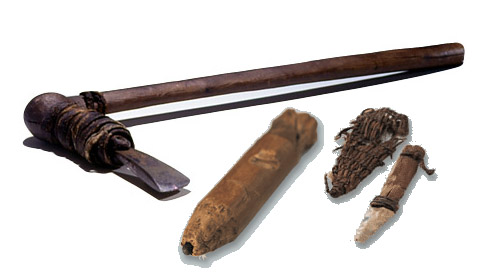Option A
Option A : Materials
Introduction
The Chalcolithic Age, an era between the Stone Age and the Bronze Age, involved the use of copper for tools but they were generally only possessed by the higher members of society and, unlike stone and bronze (which had yet to be discovered), were too soft to be in general usage. The word chalcolithic derives from the Greek words for copper and stone.

Özti's tools
One of the great examples of the Chalcolithic Age is Özti the iceman. He lived around 3200 BC and when his remarkably preserved body was discovered in the Alps in 1991 it was found that he had with him a knife with a flint (stone) head and an axe made out of yew with a copper head.
We have come a long way since man first used metal (copper) for tools. Option A covers the chemistry of materials and includes much about modern materials, for example, composites, catalysts, Kevlar® and liquid crystals as well as some more traditional chemistry such as the production of aluminium. It is relevant to students and contains a mixture of memory work, deduction from information and various different types of calculations.
If you have previously taught Option C: Chemistry in industry and society on the old programme then you will find that much of the content is similar in the current Option A: Materials although there are some notable differences e.g. the use of triangular bonding diagrams and the application of Green chemistry and atom economy. The core part of this option basically gives an introduction to the classification of materials and their properties then looks at the principles underlying the extraction of metals from their ores. There is a separate sub-topic on catalysts that includes factors affecting their choice and modes of action. This is followed by three sub-topics that are all very similar to material in the old chemistry in industry and society : liquid crystals, polymers and nanotechnology. The final part of the core is concerned with the environmental impact of plastics. The Additional Higher Level part of this option looks at superconducting metals and brings in X-ray crystallography, including the use of the Bragg equation. condensation polymers and the environmental impact of heavy metals make up the last two topics.
In common with the other three options this option contains the common four strands of quantitative, analytical, environmental and organic chemistry. These are not equally represented though. The only reference to analytical in the core is Inductively Coupled Plasma Spectroscopy together with Optical Emission Spectroscopy and/or Mass Spectrometry. Students can use the data obtained from these techniques to calculate quantitative amounts of trace metals in a sample but they are unlikely to fully comprehend the underlying theory of these spectroscopic techniques. Calculations are also covered by the use of Faraday's laws as well as the quantitative determination of trace amounts of metals. At Higher Level the calculations are more complex involving the use of the Bragg equation and units cells and equilibrium calculations with heavy metals involving solubility products.
Links
The linked pages basically follow the syllabus and take each sub-topic in turn. They start with ‘Pause for thought’, which aims to stimulate and get you (and your students) thinking about some aspect of the topic. A box follows this on how Nature of Science is addressed by the sub-topic, then learning outcomes (‘understandings’ and ‘applications and skills’), clarifications, the international-dimension, teaching tips, key vocabulary and other resources (including videos and the relevant pages in my Study Guide) and suggestions for homework. Each sub-topic has an embedded slide gallery which covers all the syllabus content and contains tasks with worked answers. For all of the topics there is an attached link leading to a separate page with original questions (together with worked answers) on the topic. Although the IB does not test the options using multiple choice questions I have also provided a quiz containing ten questions with the answers explained for each sub-topic as it provides an efficient and quick way for students to test both their knowledge and understanding.
Introductory video
Materials science is inextricably linked with engineering. This video on Materials Science and Engineering at Massachusetts Institute of Science and Technology (MIT) gives a good overview of the types of uses that modern materials can be put to and could be used as a good introduction to this option (and a spur for your students to apply to prestigious universities!).

 IB Docs (2) Team
IB Docs (2) Team